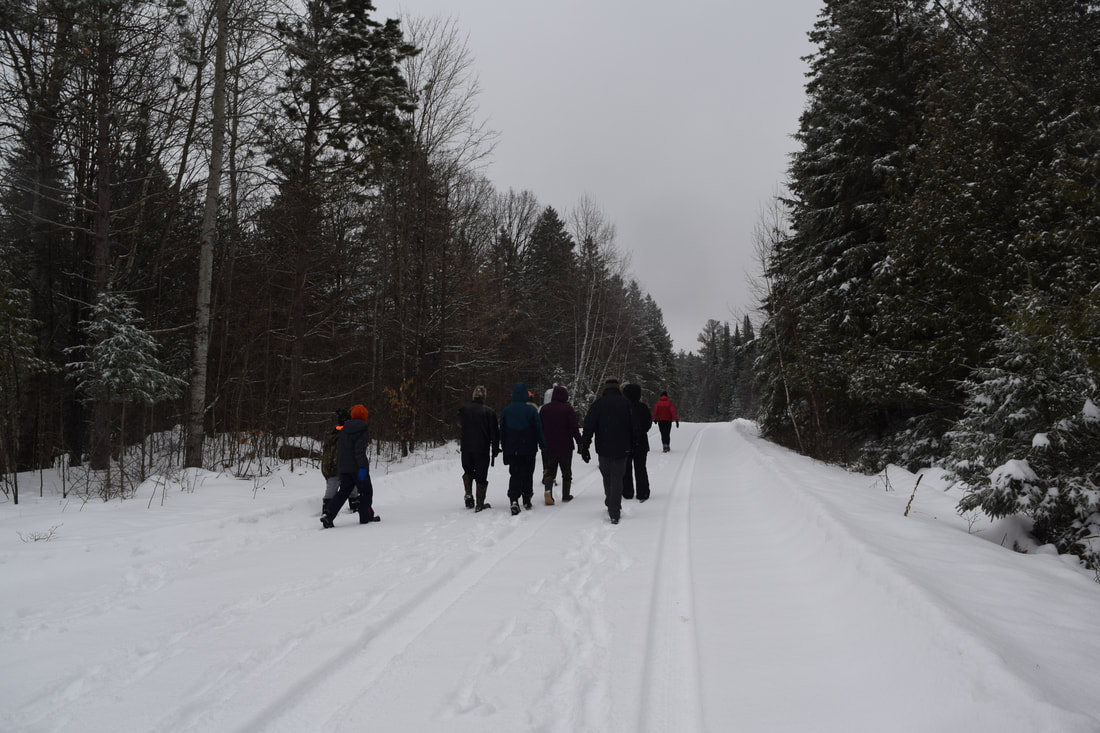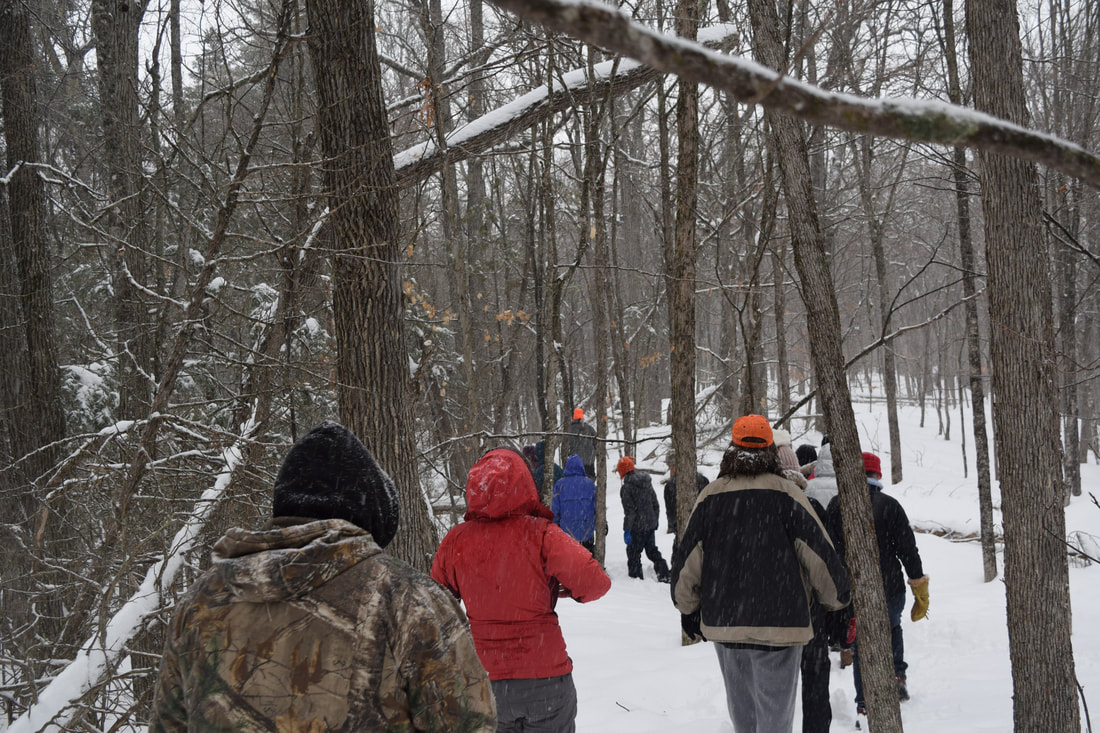|
Guest Post by Kathleen Godfrey,
A bright blanket of snow settled on the ground as we welcomed a group of 17 people – young, older, Indigenous, settler – to our Cross-Cultural Perspectives on the Land workshop, an all-day gathering held on Saturday, January 25th at the Plenty Canada office and surrounding woodland. This event was an extension of the Truth and Reconciliation Training Program, open to the public and folks of all ages. After warming up with a mug of tea or coffee, the day began with ceremony: a cleansing smudge and opening, led by Elders Larry McDermott and Barry Sarazin. As the medicine made its way around the circle, a lightness filled the space, readying us for a day of openness, learning, and community. What is ethical space? Members of the circle shared how they had come to be here, each delicately fingering the band of beads on Larry’s eagle feather as they spoke of their journeys. Then, Larry began his teaching on “ethical space”, which is a key framework for pursuing good relations with Indigenous peoples and Nations in Canada, envisioned by Piikani Blackfoot Elder Dr. Reg Crowshoe and Cree Elder Dr. Willie Ermine. In Larry’s words, “ethical space was part of how this country came together, practiced in 1764 Treaty-making. Ethical space, in essence, [is] our laws. John Borrows calls these laws ‘gifts’, of which there are seven: Love, Humility, Courage, Generosity, Respect, Truth, and Wisdom. Wisdom comes last, and love comes first, as the Creator, the Great Spirit, the activation of creation comes from love; love is also the underpinning of the Canadian constitution. Those Seven Sacred Gifts were organized into a methodology for western and indigenous cultures to engage one another, specifically academically. This methodology was founded on parallel governance, with a ‘western business model’ on one side, and oral traditional governance on the other. The goal is not to blend them, but to allow both disciplines to thrive. Ethical space is everything between those parallels, where bridges can exist. For example, a smudge is equivalent to the gavel and the Seven Sacred Gifts are equivalent to Robert’s Rules of Order.” How does ethical space apply to environmental stewardship? As a central figure in decades of conservation, forestry, and environmental dialogue in Canada, Larry was involved in a process to weave ethical space into conservation practice. He explained that in 2016, “when Canada made its decision on how to pursue its obligations under the conventions of Biological Diversity and Cimate Change, it organized the Pathway to Canada Target 1initiative.” The Pathways 1 team agreed to accept this model of ethical space, and “so the whole process of fulfilling obligations was designed to revisit the strength that occurred in 1764, the true Treaty-making. In the processes of Pathways 1, there is no boss, no one person in charge. If you’re going to honor ethical space from the Indigenous side, this is the way it has to be – it has to be a safe space, whether you identify as a woman, as Indigenous, as 2SLGBTQQIA.” Ethical space is actually embracing those Seven Gifts, it’s embracing Section 35, UNDRIP, and the 94 Calls to Action from the Truth and Reconciliation Commission. It means you bring your best intent, and the Seven Gifts help you focus that intent in a good way. “When everybody focuses their good intent, then amazing things can happen.” Everybody has a responsibility to that ethical space, to make sure that it is working for both streams, which is easier said than done. It means doing enough homework to build up cross-cultural capacity. Everybody wants to jump ahead, to fulfill those conservation targets of 17% coverage for protected area, now rising 25%, then 30%. So far those targets are very western driven and ignore the importance of relationships.” Waking up to ethical space Recognizing ethical space as gift, and as a framework for mutual understanding and respect goes beyond Indigenous and non-indigenous relations in the conservation field, applying to the broader conversation about meaningful reconciliation in Canada. As Larry puts it, “We like to pretend everything is rosy and working, and the problem with that is, if you look at the Seven Sacred Gifts, one of them is truth. If we don’t embrace truth, we will not know the solutions, nor the problems that we need to deal with. If you are truly participating in the process of reconciliation, it means that you have to accept a new governance system, a new way of meeting and sharing.” “We have to retrain ourselves. Part of ethical space is committing to that retraining.” Moving forward The group journeyed through this lesson with mmmms, slow head nods, and barely audible “yeses”. Heartbeats quickened, too. As a gathering of Indigenous and non-Indigenous people of varying ages and experiences, engaging with ethical space came as news to some and history to others. When Larry finished, the room was slow to empty for lunch. The air was heavy with reflection, brain activity, deep understanding. After sharing food together, with the morning’s lesson in our hearts and chili in our bellies, we made our way to the William Commanda Memorial Trail for a walk through the woods. The world, snowy and white, had a different hue. Embodying ethical space, we greeted our plant friends –“Hello”–, extending gentle hands to every wayward branch, pausing to learn the names and gifts of each. The day closed with a drum circle led by Barry Sarazin, the vibrations helping to settle our resolve and commitment to creating ethical space together. Chi miigwetch to all who gathered with us. ----------- To learn more, visit our Publications & Reports page, where you can find the following recommended resources, developed through Canada’s Pathways to Target 1 Process: (2018) One With Nature: A Renewed Approach to Land and Freshwater Conservation in Canada – A Report of Canada’s Federal, Provincial and Territorial Departments Responsible for Parks, Protected Areas, Conservation, Wildlife and Biodiversity (2018) Canada’s Conservation Vision: A Report of the National Advisory Panel (2018) We Rise Together: Achieving Pathway to Canada Target 1 through the creation of Indigenous Protected and Conserved Areas in the spirit and practice of reconciliation – The Indigenous Circle of Experts’ Report and Recommendations |
|
-
Home
- Donate
-
Projects
-
Canada
>
- Plenty Canada CampUs
- The Healing Places
- Two-Eyed Seeing Bird Knowledge
- Niagara Escarpment Biosphere Network
- Greenbelt Indigenous Botanical Survey
- Great Niagara Escarpment Indigenous Cultural Map
- Ginawaydaganuc Indigenous Food Sovereignty
- Indigenous Languages and Cultures Programs >
- Wild Rice
- Good Mind Grappling (partnership)
- Ginawaydaganuc Village (partnership)
- Youth Programming >
- Americas >
- Africa >
-
Canada
>
- News
- Resources
- Partners
- Contact Us
Our Location266 Plenty Lane Lanark, Ontario Canada K0G 1K0 (613) 278-2215 |
Donate to
|
Subscribe to our Newsletter |


